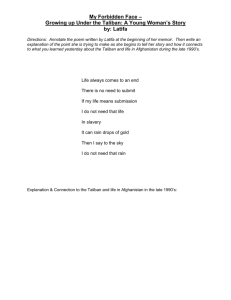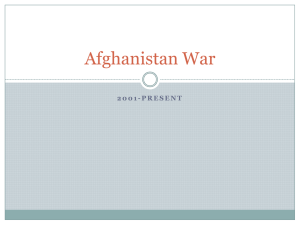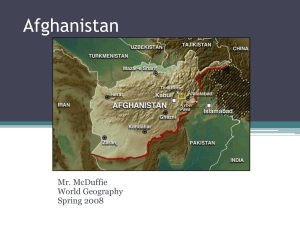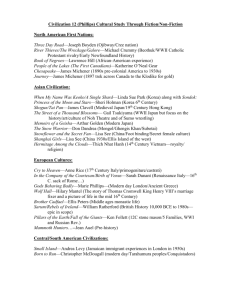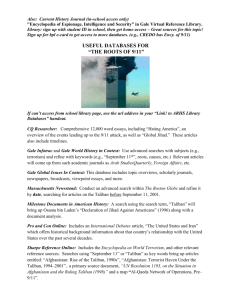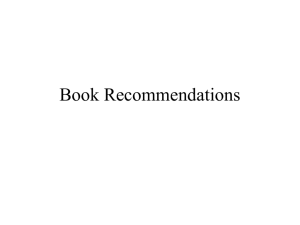Afghanistan Taliban and Al Qaeda Background
advertisement
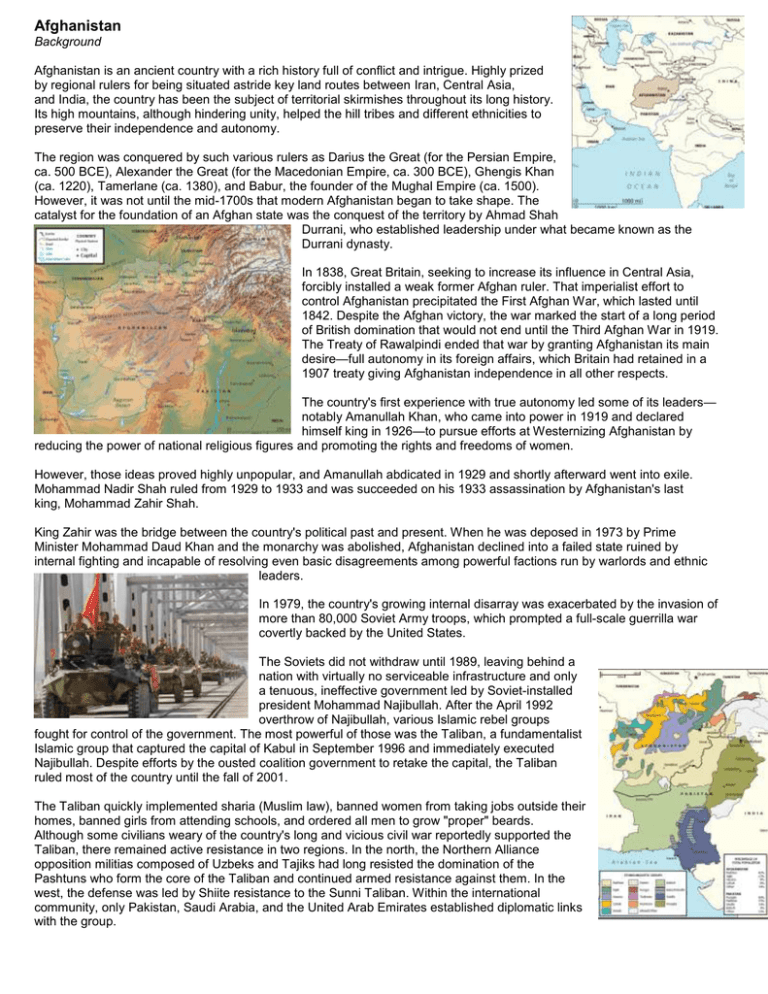
Afghanistan Background Afghanistan is an ancient country with a rich history full of conflict and intrigue. Highly prized by regional rulers for being situated astride key land routes between Iran, Central Asia, and India, the country has been the subject of territorial skirmishes throughout its long history. Its high mountains, although hindering unity, helped the hill tribes and different ethnicities to preserve their independence and autonomy. The region was conquered by such various rulers as Darius the Great (for the Persian Empire, ca. 500 BCE), Alexander the Great (for the Macedonian Empire, ca. 300 BCE), Ghengis Khan (ca. 1220), Tamerlane (ca. 1380), and Babur, the founder of the Mughal Empire (ca. 1500). However, it was not until the mid-1700s that modern Afghanistan began to take shape. The catalyst for the foundation of an Afghan state was the conquest of the territory by Ahmad Shah Durrani, who established leadership under what became known as the Durrani dynasty. In 1838, Great Britain, seeking to increase its influence in Central Asia, forcibly installed a weak former Afghan ruler. That imperialist effort to control Afghanistan precipitated the First Afghan War, which lasted until 1842. Despite the Afghan victory, the war marked the start of a long period of British domination that would not end until the Third Afghan War in 1919. The Treaty of Rawalpindi ended that war by granting Afghanistan its main desire—full autonomy in its foreign affairs, which Britain had retained in a 1907 treaty giving Afghanistan independence in all other respects. The country's first experience with true autonomy led some of its leaders— notably Amanullah Khan, who came into power in 1919 and declared himself king in 1926—to pursue efforts at Westernizing Afghanistan by reducing the power of national religious figures and promoting the rights and freedoms of women. However, those ideas proved highly unpopular, and Amanullah abdicated in 1929 and shortly afterward went into exile. Mohammad Nadir Shah ruled from 1929 to 1933 and was succeeded on his 1933 assassination by Afghanistan's last king, Mohammad Zahir Shah. King Zahir was the bridge between the country's political past and present. When he was deposed in 1973 by Prime Minister Mohammad Daud Khan and the monarchy was abolished, Afghanistan declined into a failed state ruined by internal fighting and incapable of resolving even basic disagreements among powerful factions run by warlords and ethnic leaders. In 1979, the country's growing internal disarray was exacerbated by the invasion of more than 80,000 Soviet Army troops, which prompted a full-scale guerrilla war covertly backed by the United States. The Soviets did not withdraw until 1989, leaving behind a nation with virtually no serviceable infrastructure and only a tenuous, ineffective government led by Soviet-installed president Mohammad Najibullah. After the April 1992 overthrow of Najibullah, various Islamic rebel groups fought for control of the government. The most powerful of those was the Taliban, a fundamentalist Islamic group that captured the capital of Kabul in September 1996 and immediately executed Najibullah. Despite efforts by the ousted coalition government to retake the capital, the Taliban ruled most of the country until the fall of 2001. The Taliban quickly implemented sharia (Muslim law), banned women from taking jobs outside their homes, banned girls from attending schools, and ordered all men to grow "proper" beards. Although some civilians weary of the country's long and vicious civil war reportedly supported the Taliban, there remained active resistance in two regions. In the north, the Northern Alliance opposition militias composed of Uzbeks and Tajiks had long resisted the domination of the Pashtuns who form the core of the Taliban and continued armed resistance against them. In the west, the defense was led by Shiite resistance to the Sunni Taliban. Within the international community, only Pakistan, Saudi Arabia, and the United Arab Emirates established diplomatic links with the group. The Taliban's demise was triggered by the September 11, 2001 World Trade Center and Pentagon attacks against the United States, as the group had been harboring the prime suspects in the attacks—Osama bin Laden and his Al Qaeda network. With the assistance of a U.S.-led assault on the Taliban and Al Qaeda, the opposition Northern Alliance toppled the Taliban and regained control of most of Afghanistan by late 2001. In December 2001, four major Afghan factions signed an agreement to form an interim government, led by Hamid Karzai, to rule the country until elections for a permanent government could be held. One step in that direction took place on October 9, 2004, when the nation's first-ever direct presidential election was held. On that day, Karzai competed against more than a dozen challengers and won with 55% of the vote. Afghanistan held its first direct parliamentary elections on September 19, 2005, a vote that was marred by Taliban threats and voter turnout about 20% lower than the 2004 presidential poll. As a result of the vote, on December 19, 2005, Afghanistan's 249-seat National Assembly met for the first time in 30 years. In May 2011, U.S. Navy SEALs killed bin Laden during a secret nighttime raid on his long-time hideout in Abbotabad, Pakistan. The Taliban Background The Taliban, the "Students of Islamic Knowledge Movement," the organization that controlled the largest part of Afghanistan as the 21st century began, got its start among youth that were attending madrasas, religious schools, which had been set up in Pakistan by Afghan refugees during the 1980s, at which time the Russians occupied much of the country. Most of the southern part of Afghanistan was inhabited by people who were ethnically Pashtuns and speakers of a distinctive language, Pashti. This same ethno-linguistic group was dominant in that part of Pakistan adjacent to Afghanistan. The Pashtuns were traditionally followers of a very conservative version of Sunni Islam. By the early 1990s, the Taliban had evolved into a formal organization under the leadership of a council (ulama, literally a community of learned men) and the council's leader, Mullah Muhammad Omar. Movement leaders spread through the Pashtun areas of Afghanistan and quickly gained a large following. Formed as a militia, in 1996 the Taliban moved on Kabul, the capital, and quickly took over from the divided ruling elite, who had been drawn from the Uzbek and Tajik ethnic groups whose strength lay in the north (many of whom were either Shia Muslims or secular Marxists). The defeated leaders quickly formed an alliance against the Taliban and remained in control of the northern third of the country. (Through the 1990s, the United Nations and the United States did not recognize the Taliban, considering Afghanistan a land without a government. They recognized instead the government of Shia leader Burhanuddin Rabbani, of the Northern Alliance, as the rightful leader of Afghanistan. Only Pakistan, Saudi Arabia, and the United Arab Emirates recognized the leadership in Kabul. Once in control of the capital, Taliban leaders instituted a strict interpretation of Islamic law that included traditional modest dress for women, restrictions on female education, and denying access to male physicians. It also reintroduced various forms of punishment that have largely been banished from the West (flogging, amputation of limbs, and execution by stoning). They moved to end the lawlessness that had come to many parts of the country in the wake of the Russian withdrawal, and found televisions and video cassettes offensive to Islam. Although those actions made the Taliban unpopular in many quarters, it was the destruction of large Buddhist statues, considered by many as art treasures, in March 2001 that brought widespread denouncements from around the world. In 1996 the leaders of the Taliban invited Osama bin Laden to re-establish his organization, al-Qaeda, in Afghanistan. Subsequently, al-Qaeda was charged with a series of attacks upon U.S. citizens and property, culminating in the attacks on the United States on September 11, 2001. The Taliban was implicated in these attacks because of its harboring bin Laden in Afghanistan. In October 2001, the United States began military actions in Afghanistan aimed at capturing bin Laden and his associates and destroying al-Qaeda. Secondarily, the attack has been on the Taliban as an accessory to the terrorism perpetuated by the al-Qaeda network. The attack destroyed the Taliban government but by no means destroyed the organization. It retreated into the rural areas of the country and has continued to put up resistance. The Taliban's fighting strength during the October–November 2001 battles with the Northern Alliance was about 45,000, and many of these were killed or captured. The remnants (numbering in the hundreds) retreated, along with Al Qaeda fighters, into mountain refuges in eastern Afghanistan along the Pakistani border. U.S. efforts to blast them out of the rugged terrain proved difficult and could not totally eliminate Taliban bands that survived there and across the border in Pakistan's North and South Waziristan provinces. Taliban strategy shifted to terrorist tactics, and they conducted a guerrillastyle insurgency launched in earnest in 2003. The insurgency expanded from 2003 to 2009, and the Taliban has reestablished a presence throughout the areas in Afghanistan from which it was swept in October–November 2001. Estimates of current Taliban military strength range from 7,000 to about 11,000, but these figures do not include thousands of supporters (who sometimes participate in terrorist attacks) who are opposed to the Hamid Karzai regime or who resent the presence in Afghanistan of U.S. and North Atlantic Treaty Organization (NATO) troops (referred to as “foreign Crusaders” in Taliban propaganda to evoke historical images of the Christian assault on Islam in the 11th through 13th centuries). Taliban insurgency tactics include suicide bombers, the use of improvised explosive devices (IEDs), and launching rockets at urban areas. During the run-up to the August 2009 Afghan elections, the Taliban increased terrorist attacks throughout the country and demanded that Afghans boycott the election—actions that kept voter turnout lower than the 2004 election. Taliban recruitment, particularly of Pakistanis, has increased, despite U.S. and NATO targeting of Taliban leadership through air attacks. Al Qaeda Background The terrorist organization Al Qaeda is determined to end all U.S. influence in Islamic nations. Al Qaeda and its founder, Osama bin Laden, are believed to be responsible for many of the worst acts of terrorism of the late 20th century and early 21st century, including the World Trade Center and Pentagon attacks in the United States, which killed nearly 3,000 people. Bin Laden founded Al Qaeda in his native Saudi Arabia in the late 1980s after he helped bring an end to the Afghanistan invasion by the Soviet Union. His initial aim was to use Al Qaeda to overthrow all pro-Western governments in Islamic nations, and he was able to recruit many of the members of the Islamic Alliance of Afghan Mujahideen that fought side by side with him inAfghanistan. Bin Laden's goal for Al Qaeda began to change during the Persian Gulf War, when he became incensed at the presence of U.S. soldiers in Saudi Arabia. He decided to use Al Qaeda to eliminate all U.S. influence in Islamic nations around the world, as well as to destroy Israel. In 1991, he was expelled from Saudi Arabia and quickly established Al Qaeda's headquarters in Khartoum, Sudan. Under pressure from Saudi Arabia and the United States, Sudan expelled bin Laden in 1994, and he switched Al Qaeda's base of operations to Afghanistan. Under the protection of the ruling Taliban, bin Laden used his extensive personal wealth to help set up several terrorist training camps in Afghanistan. Most estimates suggest that several thousand Islamic militants from such countries asEgypt, Pakistan, and Saudi Arabia trained at those camps and then disappeared into terrorist cells all over the world. Disillusioned youth from such Western nations as France, Germany, and Sweden have also joined Al Qaeda and participated in terrorist acts against Western targets. Bin Laden issued a declaration of war against the United States in August 1996 and then issued a fatwa (religious decree) in 1998 that proclaimed it the duty of all Muslims to wage jihad(holy war) on the United States and its citizens, as well as against all Jews. Even before bin Laden issued his proclamations, U.S. military forces and citizens were the victims of several terrorist acts believed to be linked to Al Qaeda, including the killing of U.S. soldiers during the Battle of Mogadishu in Somalia in 1993 and the World Trade Center bombing that same year. Al Qaeda continued to focus on U.S. targets throughout the 1990s, and it is suspected of being involved in the U.S. Embassy bombings in Africa in 1998 and the bombing of USSCole in Yemen in 2000. However, its most notorious act of terrorism, the attack on the World Trade Center and the Pentagon on September 11, 2001, has led to an all-out war on terrorism led by the United States, with bin Laden and Al Qaeda as the primary targets. Following the September 11 attacks, the United States used U.S. special forces and an extensive bombing campaign to overthrow the Taliban. It then sent in ground troops to hunt down all suspected terrorists, and they have killed or captured hundreds of Al Qaeda members in Afghanistan, including several top lieutenants. Worldwide, more than 3,000 extremists with suspected ties to Al Qaeda have been arrested in about 90 different countries. U.S. officials believe that military committee commander Muhammed Atef was killed during a November 2001 air strike in Afghanistan. In March 2002, Abu Zubaydah, who is reportedly Al Qaeda's top operational commander, was captured in Pakistan. In March 2003, Khalid Sheikh Mohammed, the alleged mastermind behind the September 11 attacks, was captured and has been held at an undisclosed location since that time. However, U.S. officials admit that there are still potentially thousands of Al Qaeda members hiding in terrorist cells all over the globe. Bin Laden himself evaded capture until he was killed in a May 1, 2011, raid by U.S. forces at the compound in Pakistan where he was hiding. Still at large is one of bin Laden's most trusted advisers in Al Qaeda, Ayman al-Zawahiri, an upperclass Egyptian doctor who is Al Qaeda's theological leader and helps oversee Al Qaeda's loosely organized network of terrorist cells that operate independently of each other, which makes it hard for authorities to capture more than one cell at a time. Abu Musab al-Zarqawi, a Jordanian who fomented much of the antiU.S. and anti-Shiite insurgency in Iraq after the start of the Iraq War in March 2003, was killed by a U.S. air strike in June 2006. Al Qaeda serves as an umbrella organization for a worldwide network of terrorist groups that have similar aims.
